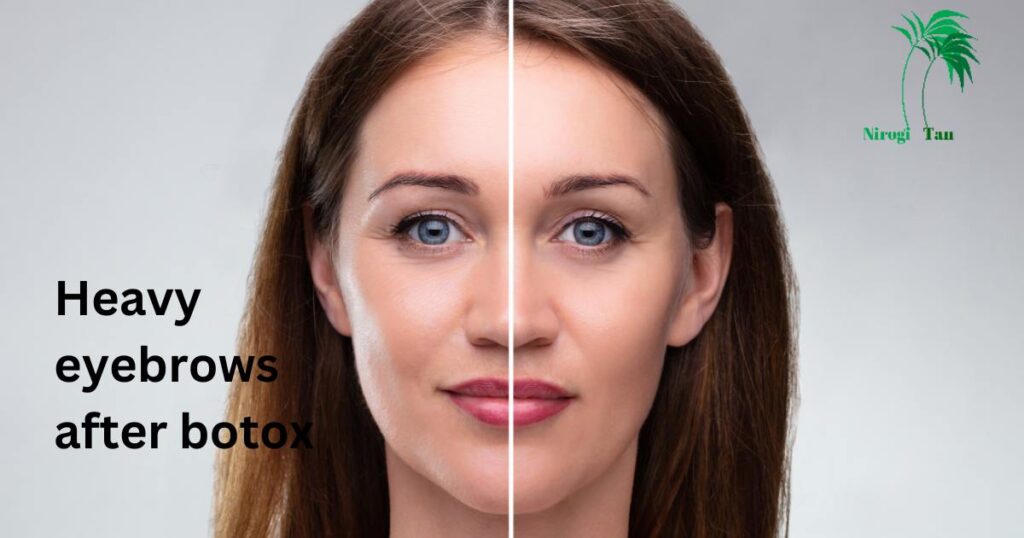Botox is a well-known cosmetic technique that is used to hide fine lines and wrinkles on the face. It functions by momentarily paralysing the wrinkle-causing muscles, making the skin look smoother and younger. Heavy brows are one of the negative effects of Botox therapy that have been noted. The topic of heavy brows following Botox treatment will be covered in this article, along with its causes, prevention strategies, and remedies.
Describe Botox
The bacterium Clostridium botulinum produces a neurotoxic protein known as botulinum toxin, which is sold under the brand name “Botox.” It is a common cosmetic procedure for minimising the appearance of wrinkles and fine lines on the face because, when injected in modest doses, it temporarily paralyses or weakens muscles. Botox smoothes out wrinkles and stops the development of new ones by obstructing the signals that typically trigger muscles to contract. Botox is a prescription medication that is most frequently used to cure wrinkles around the lips, forehead, and eyes. It is also used to treat migraines, excessive sweating, and muscular spasms. It’s crucial to remember that only trained and experienced professionals should administer Botox.

What exactly are heavy brows?
When the eyebrows are heavy, sometimes referred to as “brow ptosis,” they appear to be lower than they should be on the face. Ageing, certain medical disorders, genetics, and other factors can all contribute to this. In some situations, receiving Botox therapy may also result in heavy brows. In addition to contributing to the appearance of wrinkles and fine lines on the forehead, heavy eyebrows can give the face a fatigued or furious aspect.
Eyebrows that appear to be drooping or sagging are referred to as heavy eyebrows. This is a side effect of Botox treatment and is brought on by the paralysis of the brow-raising muscles. The eyebrows cannot be raised when these muscles are paralysed, giving them a heavy or droopy appearance.
The muscles that lift the eyebrows might become weak or relaxed, which can result in heavy-looking or drooping eyebrows. This can happen due to ageing naturally or through temporary paralysis of certain muscles brought on by Botox injections. In some circumstances, medical problems like Bell’s palsy, which can damage the facial muscles, can also contribute to heavy brows.
It is crucial to remember that heavy brows can also be a natural and appealing characteristic for some people, and they should only be altered if they are causing aesthetic or practical problems. It’s critical to consult a trained and knowledgeable dermatologist or cosmetic surgeon if you have heavy brows to identify the best course of action for your particular needs.
Depending on the underlying cause, there are numerous therapies that can be used to cure heavy eyebrows. When ageing or genetics are to blame for having thick eyebrows, a surgical brow lift may be required to raise the eyebrows to the ideal position. A corrective Botox injection or waiting for the effects of the initial treatment to wear off may be required if heavy eyebrows are a side effect of Botox treatment. If a medical condition is to blame for your heavy brows, you may need to get the underlying illness treated in order to get rid of the problem.
Why do my brows get heavy after Botox?
After receiving Botox, heavy brows can occur for a number of reasons. The incorrect placement of a Botox injection is one of the most common reasons. The eyebrow-controlling muscles may become paralysed if Botox is put into them, which will result in the eyebrows drooping.
The use of excessive amounts of Botox is another potential factor in thick brows following Botox. The muscles in the face may become too paralysed if too much Botox is injected, which will result in heavy or droopy eyebrows. Finally, the natural ageing process might contribute to heavy eyebrows after Botox. Age-related muscle and skin elasticity loss can result in sagging and drooping of the eyebrows.
How may heavy brows be avoided after botox?
After receiving Botox treatment, heavy brows can be avoided in a number of ways. Selecting a trained and experienced dermatologist or cosmetic surgeon to undertake the surgery is among the most crucial tasks. An expert will be aware of the proper injection sites and will use the right dosage of Botox to prevent over-paralyzing the muscles.
Avoiding touching or massaging the area that has received the injections is a further crucial step in preventing heavy brows after Botox. Touching or rubbing the area increases the risk of the Botox spreading to other muscle groups, which may result in unfavourable side effects including droopy eyebrows.
For at least 24 hours following a Botox procedure, it’s crucial to refrain from vigorous exercise or other activities that stimulate facial blood flow. By doing so, you may be able to stop the Botox from spreading to other parts of your face. Finally, it’s crucial to adhere to the dermatologist or cosmetic surgeon’s post-treatment advice. In certain cases, this entails staying away from drugs or supplements that raise the possibility of bleeding or bruising.
How to handle heavy brows following botox
There are various viable treatments if thick brows develop following Botox. Waiting for the Botox to wear off naturally is one possibility. The heavy eyebrows should go away on their own between three to six months after receiving Botox, which is how long it normally lasts.
Depending on the severity of the problem and the specific demands of the person, there are various treatment options available to reduce thick eyebrows after Botox.
Read more: Food intolerance testing – is it worth it?😱
The following are some of the most popular medical remedies:
Watch for the Botox effects to fade:
The effects of Botox are transitory and usually last between three and six months. Heavy brows may occasionally be a transient adverse effect of the procedure that will go away on its own when the Botox’s effects wear off.
Receive a corrected injection of Botox:
If heavy brows continue after the benefits of the first Botox treatment have worn off, a corrective injection of Botox can be given to weaken the muscles that are creating the heavy brow appearance. This procedure can assist in lifting the eyebrows back into place, giving the face a more young and revitalised appearance. It is significant to remember that only a trained and experienced practitioner should deliver corrected Botox injections.
Undergo a surgical brow lift:
A surgical brow lift may be required to raise the eyebrows to the appropriate position when they are too heavy due to ageing or genetics. In order to move the eyebrows higher on the face during this surgery, incisions are made in the scalp and the skin is lifted. Although this is a more invasive alternative for treatment, the effects can be substantial and long-lasting.
A trained and experienced dermatologist or cosmetic surgeon should be consulted to identify the best course of action for your particular circumstances. They will be able to evaluate your particular situation and suggest the best course of action in light of your objectives and medical background. Additionally, in order to guarantee that the treatment is efficient and secure, it is crucial to adhere to all post-treatment recommendations and show up for any required follow-up sessions.
Conclusion
After receiving Botox, heavy brows might be an unintended and unexpected side effect. To avoid thick eyebrows, it’s crucial to select a cosmetic surgeon or dermatologist who is qualified and knowledgeable and to follow all post-treatment guidelines. There are a number of treatment options available if heavy brows do develop, including waiting for the Botox to gradually wear off, getting a correction injection of Botox, or having a surgical brow lift. The dangers and benefits of any cosmetic surgery should be carefully considered, and any decision should be made with the help of a skilled specialist.
It’s also essential to have realistic expectations for the results of Botox treatment. Even while it can be a successful method for reducing the visibility of wrinkles and fine lines, it is not a permanent cure and requires follow-up treatments to maintain the intended benefits. It’s also important to remember that, despite the fact that heavy brows after Botox might be an annoyance, they are only a temporary issue that can be fixed with the proper maintenance.
If you’re considering Botox treatment, it’s important to do your research, choose a qualified and experienced practitioner, and follow all post-treatment instructions in order to minimize the potential of adverse side effects. If you do have heavy brows, there are treatments you can use to solve the issue following Botox. However, it is essential to seek the guidance of a knowledgeable expert in order to ensure that the issue is treated securely and effectively.

